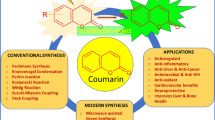Summary.
Two different types of conformational changes of the biliverdin chromophore were accomplished by the concept of reducing sterical hindrance. On one hand, model compounds unsubstituted at position 7 and/or 13 adopt the semi-extended geometry with anti-conformation of the dipyrrinone moiety. On the other hand, stretching of the chromophore with anti-conformation of the dipyrrin substructure was achieved with a model compound unsubstituted at position 12. Both kinds of anti-conformations have been proved by 2D NMR and UV-Vis spectroscopy.
Similar content being viewed by others
Author information
Authors and Affiliations
Corresponding author
Additional information
Current address: Voestalpine Stahl GmbH, Voest-Alpine-Straße 1, A-4020 Linz, Austria
Rights and permissions
About this article
Cite this article
Hölzl, M., Jarosik, A. & Grubmayr, K. Inducing anti-Conformers of Biliverdin Chromophores by Reducing Sterical Hindrance. Monatshefte für Chemie 136, 747–754 (2005). https://doi.org/10.1007/s00706-004-0268-5
Received:
Accepted:
Published:
Issue Date:
DOI: https://doi.org/10.1007/s00706-004-0268-5




